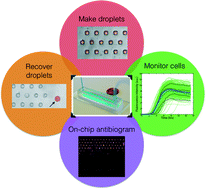Universal microfluidic platform for bioassays in anchored droplets†
Abstract
In spite of the large number of droplet-based microfluidic tools that have appeared in recent years, their penetration into non-specialist labs remains limited to a small number of applications. This is partly due to the lack of a generic platform that integrates all of the necessary operations for end-users, and partly to the increasing complexity that emerges as several operations are combined together. Here we report the development of a platform that provides the capabilities of multiwell plates in a two-dimensional array of nanoliter droplets: encapsulation, time-resolved monitoring and variation of well contents, as well as the ability to selectively extract the contents of any of the wells. We demonstrate these capabilities by encapsulating thousands of individual bacterial cells in droplets that are stored on a two-dimensional array of surface-energy anchors. Bacterial culture can be performed either in liquid or hydrogel droplets, both of which allow precise quantification using either standard measurements or digital enumeration. Using hydrogels allows the removal of the external oil that surrounds the aqueous drops, for instance in order to apply a gradient of antibiotics across the droplet population. This defines a protocol to obtain an antibiogram in a single experiment. Finally, the liquid to gel transition provides a robust way to selectively extract any droplet from the array, by melting it with a focused laser. When combined with further off-chip culture or genotyping, this platform provides a unique culturing environment to relate phenotype and genotype measurements on monoclonal colonies.



 Please wait while we load your content...
Please wait while we load your content...